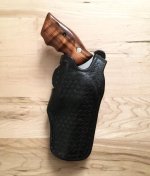I used a Safety Speed clamshell holster for my LAPD M67 for about 5 years, until they authorized semi-autos, from about 1981-86. That, IMO, was a great holster! Very lightweight -- I tried a Hoyt breakfront-drop holster for about a week and that thing weighed a ton, so I sold it. The clamshell also had a very fast draw. In particular, you could get your weapon out super fast while sitting in a car without any weird arm or shoulder movements that broadcast what you were doing. LAPD in 1981 had issued us non-drop breakfront holsters (Safarilands?) but I put mine aside as soon as I graduated the Academy. There were some other maker knockoff clamshells out there but IIRC LAPD outlawed those -- only the Safety Speed was authorized. The finger-in-the-trigger-guard thing that seems to freak out modern cops was no problem -- what freaks me out is cops today running around with those striker fired things, which I think are prevalent because some female cops and some men don't have the hand strength to fire a revolver or DA/SA handgun effectively.









